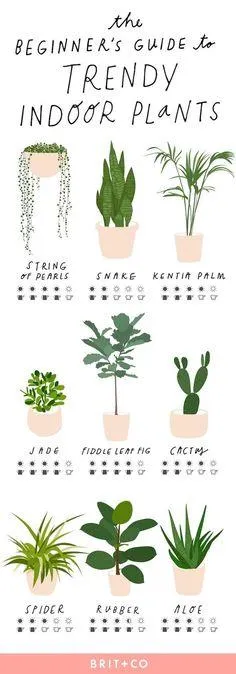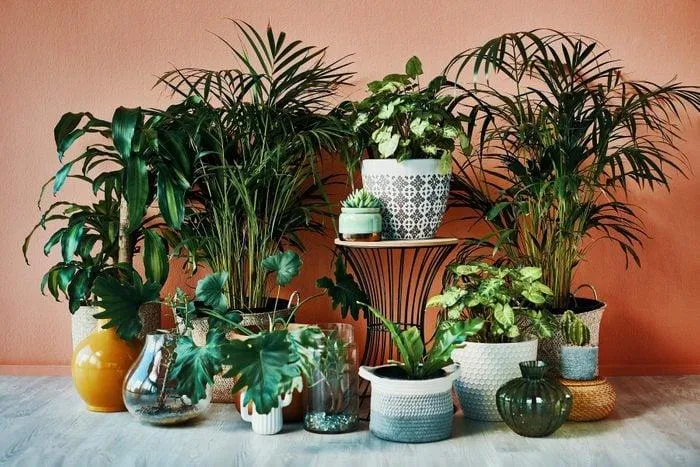The Best Indoor Wall Plants Based on Your Needs
If you’re looking for greenery to brighten up the walls in your home or office, you’ve come to the right place. There are several excellent indoor plant options that can thrive when planted directly in soil or a hanging planter on a vertical surface. In this article, we’ll explore the top wall plants suited for different conditions and needs.
Low Light Requirements
For areas with minimal natural light, consider these versatile varieties:
- Pothos – Also known as devil’s ivy, pothos is famously tough and can survive in very low light. Just water when the top inch of soil dries out. I have a pothos planted in a dark hallway that’s still thriving years later!
- Philodendron – With their heart-shaped leaves, philodendrons also do well in low light. ‘Brasil’ and ‘Heartleaf’ varieties adapt especially well to indoor walls. Their lush foliage trails beautifully over the side of planters.
- Chinese evergreen – If you want bold, colorful foliage, Chinese evergreen is a great pick. Just give it a spot with occasional natural light or bright, indirect artificial light.
High Light/Bright Areas
For sunnier locations, these fast-growing plants prosper:

- English ivy – A classic choice that climbs tenaciously up walls. English ivy thrives in full sun and self-clinging varieties don’t require a planter. Just beware that it can seed invasively outdoors.
- Spider plant – Their long, grass-like leaves dangling from hanging planters look stunning in a bright room. Propagate new plant babies effortlessly from plantlets on mothers’ flowering stems.
- Swedish ivy – Similar to pothos but with variegated heart-shaped leaves, Swedish ivy handles direct sunlight beautifully on an east- or west-facing wall.
No Maintenance Requirements
For occupants who travel frequently or have little time, these practically care for themselves:
- ZZ plant – Known as a “hardy” houseplant for its resilience, ZZ plants can go weeks without water. Their stripey green and white foliage looks lush without fussy care. One of my low-maintenance favorites!
- Snake plant – Thrivers rather than survivors, snake plants filter toxins from the air. Water every 2-4 weeks and virtually forget about them. Their stiff, sword-like leaves add lovely texture to any space.
- Air plant – These quirky Tillandsia varieties don’t require soil at all, just occasional fresh water misting or brief soaks. Display them in small pots, terrariums, or mounted directly onto walls for a modern accent.
Pet-Friendly
If you have furry friends who may nibble or knock over plants, go for:
- Peace lily – Toxic to cats and dogs if ingested, but their lily pads won’t tempt nibbling. Peace lilies flourish with average care and signal when thirsty with drooping leaves.
- Spider plant – Non-toxic and fast growing. Babies readily root when detached if your pet decides to “prune.” They come in ornamental varieties too for visual appeal beyond their pet-safety.
- Chinese evergreen – As an indoor wall plant, Chinese evergreen stays high out of reach of curious paws. Its colorful foliage is also considered non-toxic to animals.
With so many great options to choose from, you’re sure to find the perfect indoor wall plant to match your needs and space. Experiment with a few varieties to see what thrives best in your conditions. And don’t forget to share photos of your leafy installations – green walls are always Instagram worthy!

I hope this guide has provided a basic rundown on plant preferences to address the various user intentions of planting greenery indoors. Feel free to reach out if you need any other planty tips! Wishing you happiness, health and houseplants.
Top Indoor Wall Plants
| Plant | Description | Care Level | Growth Rate | Max Height |
|---|---|---|---|---|
| Pothos | Heart shaped leaves that vine, tolerant of low light | Low | Moderate | 10 feet |
| Philodendron | Large leaves with vining stems, highly tolerant of low light | Low | Moderate | Unlimited, can be trained up a support |
| English Ivy | Evergreen vines with rounded leaves, thrives in low light and humidity | Low | Fast | Can grow more than 30 feet tall outdoors |
| Spider Plant | Grasslike leaves with miniature plantlets along leaf edges, extremely hardy | Low | Moderate | 2-3 feet |
| Chinese Evergreen | Leathery deep green leaves that come in variegated varieties, tolerant of low light | Low | Moderate | 3-6 feet |
FAQ
-
What types of plants grow well on walls indoors?
Ivy, pothos, spider plants, and philodendrons are some good picks for indoor wall gardens. They have climbing vines that attach easily and don’t need much sunlight. English ivy is basically foolproof.
-
How do I plant them on the wall?
Drill drainage holes in any planters or pots before mounting them on the wall. Then use hooks, brackets, or adhesives to fasten the planters. Pothos and philodendron vines can even be stuck directly onto the wall using sticky tack or small picture hangers on their stems. Just be kind of careful not to damage the paint.

-
Do they need any special care?
Wall plants need slightly less water than ones in pots on the floor. Check the soil occasionally and water when the top inch feels dry. They also need fertilizer during the growing seasons in spring and summer. But other than that, the climbing habit makes them pretty low maintenance. These vines sort of take care of themselves!
-
Will they grow well without sunlight?
It depends on the variety. Pothos, philodendrons, and english ivy can survive in very low light. Spider plants need a bit more to bloom. However, all plants will grow more slowly without much natural light. A grow light may help if the wall gets no sunshine. But some climbing vines can still look amazing even in shady indoor spots.
-
How often should I prune them?
There’s no need to prune tiered planting vines often, if at all. You can trim off any brown or dying stems whenever you see them. Otherwise, just let the plants climb wild and wonderful! They may need a light trim once a year or so to control size. But overall, wall plants are pretty low maintenance as far as pruning goes.

-
Are any plants poisonous or unsafe?
On the other hand, there are a couple plants you’ll want to avoid mounting on interior walls. English ivy berries can actually be sort of toxic to small kids and pets if eaten. So keep that away from young children’s reach. And bamboo or pothos with dangling aerial roots could possibly damage the wall over time with their strong growth. Stick to trailer vines for easygoing indoor wall gardening.
-
Any tips for attracting more pollinators?
That’s an awesome idea, but indoor walls usually don’t get many pollinator visitors. Perhaps try growing herbs like mint or basil alongside the vines. Their aromatic leaves may lure in the occasional bee or hoverfly. You could also put up a mini feeder with sugar water nearby. But to be honest, wall plants are more for decor than biodiversity indoors. If pollinators are a priority, an outdoor garden is more effective.
So in summary – ivy, pothos, philodendrons and spider plants are great climbing vines for indoor walls. They add beauty effortlessly with minimal care. Just be careful not to choose any poisonous varieties where small kids could reach. Overall, tiered wall planters are really nice way to green up a home inside or out!
